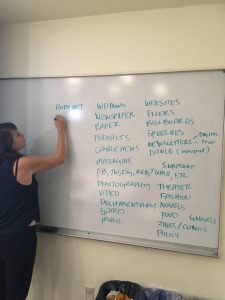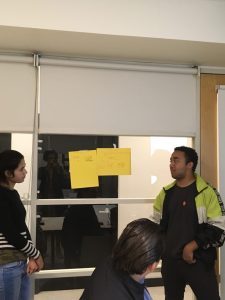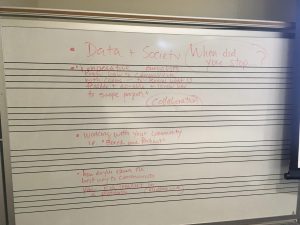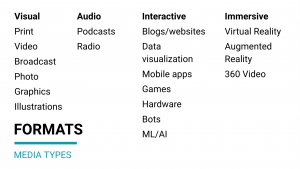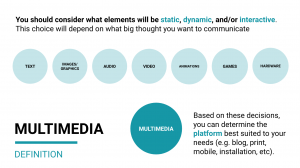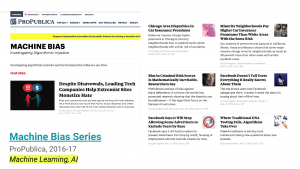Different Formats, Different Stories

Today I had the fantastic pleasure of teaching my first section as Designer in Residence at the Journalism+Design program at the New School.
- Listing media formats
- Presenting prototypes
- Pull quotes, things to remember
One of the amazing professors I’m working with is Kia Gregory who is teaching a senior capstone class. The goal of the class was to prepare students to start thinking critically about how different media format impact how their stories are communicated. In other words, to emphasize the design aspect of the program. In journalism today, a story is often combined with many different media elements, then packaged together to create a cohesive experience. But how do you encourage emerging journalists to consider themselves as designers of that experience, not just as journalists and storytellers?
Over the last year or so, I have come to deeply appreciate the value of defining terminology to promote a shared understanding of concept from the outset. Words have many connotations and assumptions built into them based on who is speaking and what context they are spoken in. So, we began by defining what media is and listing different types of media formats people use to communicate stories. As students called out formats, they began with the usual suspects: print, photo, video, etc then moved onto games and in the last few minutes came up with a few nontraditional examples such as fashion and graffiti.
We compared their list to the one I had made then discussed how different media elements combine to form multimedia storytelling. Next we looked at a few examples of successful executions of nontraditional uses of multimedia in journalism.
I presented them with a set of initial criteria they could use to evaluate how to determine a platform. It’s important here to emphasize initial. As journalist designers, they will need to come up with their own set of guidelines to inform this part of their practice. I positioned these as a jumping off point of a broader conversation for them to add new criteria or remove those they did not find helpful. For example, one student added accessibility as an important consideration and we decided to place it under the usability category (for now). The audience category in particular surfaced some critical questions around how much control the journalist has over this and to what extent the journalist is speaking to the audience of their choosing or that of their media outlet, so much so that we tabled it for a larger discussion in another class.
MAIN IDEA
- What is the one thing you want people to take away?
- What do you want them to feel/do/think after experiencing your story?
- What value are you adding? I.e. How many ppl have written about this before?
AUDIENCE
- Who is your audience? Who do you want to reach?
- What platforms do they use in their daily life?
- Where do they get their news from?
- What do they care about? What are they interested in?
- What role might they play in your story?
NARRATIVE
- How will you open your story to keep the audience engaged?
- Who are your characters? How do you want to convey them?
- What is the setting? Local? National? Global?
- Is there a conflict or a transformation?
USABILITY
- How will you guide or allow people to navigate through your story?
- Is your interface intuitive?
- How will you keep your audience’s attention?
- How accessible is it?
Using these criteria, we evaluated how well the big thought behind a NYT story was communicated via the media format chosen. As a long format piece with small and large photos, an abrupt survey dumped in the middle, and a few static graphs, it was a wonderful starting point to generate a conversation about other ways the main idea could have been presented.
For the final activity, students worked in small groups to brainstorm how they would translate the story’s big thought into another format, then create a quick paper prototype to demonstrate their idea. One group chose to create a game focused on the broken system of housing court and resident eviction while the other group offered a 3 minute video highlighting one of the main characters.
Overall, I’d call this a successful class, but I have a bunch of ideas for future iterations:
- have students come up with their own set of evaluation criteria first
- have students work in small groups to evaluate a story in depth based on one criteria
- a bit more time for prototyping (we only had 7 minutes)
- deeper reflection on how their prototypes aligned to the main idea.
I closed with a core mechanic analogy: In game design, every game has a set of core mechanics that help a player achieve the goal. You can largely attribute a game’s success to the alignment of the mechanics and the goal. For example, in basketball, the goal is to score the most points by placing a ball in a high hoop. The core mechanic is throw or shoot the ball – if we changed the core mechanic to kicking, it would probably not be as fun (and much more difficult) therefore not as successful. In choosing a media format for journalists to communicate the big thought behind their story successfully, it is helpful to consider how the action of experiencing the story (i.e. the core mechanic) impacts how the big thought is communicated (i.e. the goal). This analogy still feels a little rough, but I’ve got a whole semester to continue thinking about it.
You can access the full slide deck here. It is available to use and modify freely for educational purposes.
